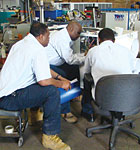
Dave Smith (right) says that technicians taking the training classes are not afraid of R-410A, but they are concerned about its high head pressure.
With 15 offices scattered around the country, Topp can respond to customer needs from nationwide locations. While that is great for customers, it was a challenge when it came time to train the company’s many technicians in the use of R-410A. In 2008, the decision was made to bring all company technicians to the Philadelphia-area office, so they can learn about R-410A during one- or two-day training sessions.
TRAINED FOR THE PHASEOUT
The ongoing training sessions cover all the basics regarding the safe handling and use of R-410A, including evacuation, safety, environmental advantages, pressure requirements, and upgrade requirements. When finished, technicians are tested on their knowledge of R-410A, and if they pass a final test, they are considered qualified to charge units with R-410A, repair leaks, and recover refrigerant.John J. Rinck, national sales and service manager, Topp Portable Air, noted that class participants are eager to learn the technical aspects of the upgrade and conversion to R-410A, but they are also concerned with line sizing and pressure differences.
In fact, the higher pressure of R-410A is often asked about in class, said Dave Smith, service manager - Pennsylvania, Topp Portable Air. “Technicians are not afraid of R-410A,” said Smith. “But they are concerned about the high head pressure with R-410A because it is so critical for the equipment to run properly.”

When finished taking the training class, technicians are tested on their knowledge of R-410A.
Once finished with the training class, technicians are able to perform warranty and repair work on customer units and on the company’s rental inventory of R-410A units. Right now, about 90 percent of the portable air conditioning fleet still uses R-22, said Smith, so there haven’t been many opportunities to try out their skills on R-410A equipment.
“We’ll have to wait for a unit to need maintenance and repairs first,” said Smith. “We’ve only had a handful of R-410A units we’ve had to look at so far.” Smith explained that the company will phase-in R-410A units as the R-22 machines can no longer be repaired.

Topp’s ongoing training sessions cover all the basics regarding the safe handling and use of R-410A, including evacuation, safety, environmental advantages, and pressure requirements.
The company actively advertises its new equipment that utilizes R-410A, as that is a feature that is appealing to environmentally conscious customers, said Rinck.
Now that the majority of Topp Portable Air technicians have been trained, they are ready to hit the ground running with R-410A. “We are ready and capable of supporting the R-22 phaseout,” said Rinck.
Publication date:11/23/2009






